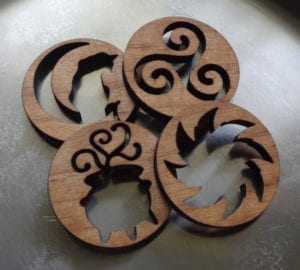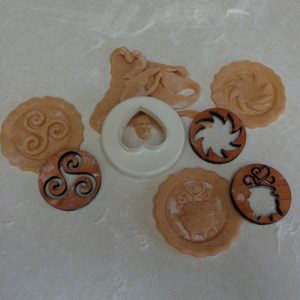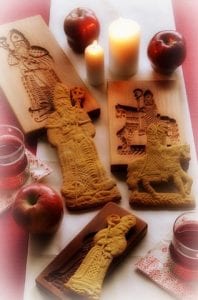 Four alder wood laser cut cookie stamps.
Four alder wood laser cut cookie stamps.
Just under two inches in diameter, they have been bathed in beeswax and grapeseed oil. Please wash by hand in warm soapy water. Not recommended for a dishwasher.
Triskele – diverse, complex and varied are the meaning of this symbol. Probably most well know as the symbol on the alter stone at Newgrange, the triple spiral has many other paths worth exploring.
Turning of the Wheel – representing eight celebration days in agrarian life and their relationship to the sun, eight points of flame, repeatedly cycling through the seasons of the year.
Steaming Cauldron – a symbol of transformation, change and rebirth. Over a hearth, cauldrons served as the hub of the house. Cooking, as well as soapmaking and bath water came from what for many familes was their finest object.
Cat on Cresent Moon – looking down from either the waxing or waning moon, she watches. Sacred to Diana, in ancient Rome, the cat was also thought of as a guardian of homes and a symbol of domestic goodness. Muslim, Norse and Egyptian traditions also have strong connections to cats in their herstories.
 Set of Four Cookies Stamps $19.00 Canadian
Set of Four Cookies Stamps $19.00 Canadian
 Roll out dough and cut circles either with a glass or scalloped edge cookie cutter.
Roll out dough and cut circles either with a glass or scalloped edge cookie cutter.
Tap stamp in flour and push down into the center of the precut cookie. Bake.
Try this recipe for Speculaas but any other favourite rolled cookie recipe should do the trick. If the press sticks, tap again in flour or cool dough for 10 minutes in the fridge.
So gather round your kitchen table or counter and tell the tales of bygone days while putting a batch of imprint cookies together for friends and family or Cakes and Ale.
 If you would like a little more of the story…..
If you would like a little more of the story…..
Imprinted food has been around for many centuries. Lebkuchen, Speculatius and Springerle are Germanic examples of what are now thought of as Christmas cookies.
The winter solstice in Germanic areas was celebrated as Julfest with among other things, animal sacrifices; a request to the Gods for a gentle winter and early spring. Not all families had the wealth for such an offerings and so a tradition of using baked goods in the shape of animals came into being. These cookies acted as tokens and over time came to include other special occasions, such as engagements, weddings and birth. It was common to exchange imprint cookies at these times, a little like the cards that were exchanged in the decades before email.
 In England, there is an Easter tradition, started in 1134, associated with Chulkhurst sisters. It continues today in Kent, an honouring of their gift to the local church.
In England, there is an Easter tradition, started in 1134, associated with Chulkhurst sisters. It continues today in Kent, an honouring of their gift to the local church.
Queen Elizabeth I is said to have gifted visitors to her court with gingerbread cookies made with images.
The idea of decorating foods with symbols is by no means new. Beyond Europe, archeological finds in India, Egypt and what used to be Mesopotamia include stone and clay molds thought to have been used in the decorating of flatbreads.
Homemade molds were commonly carved from wood but clay and metal molds were also used.

